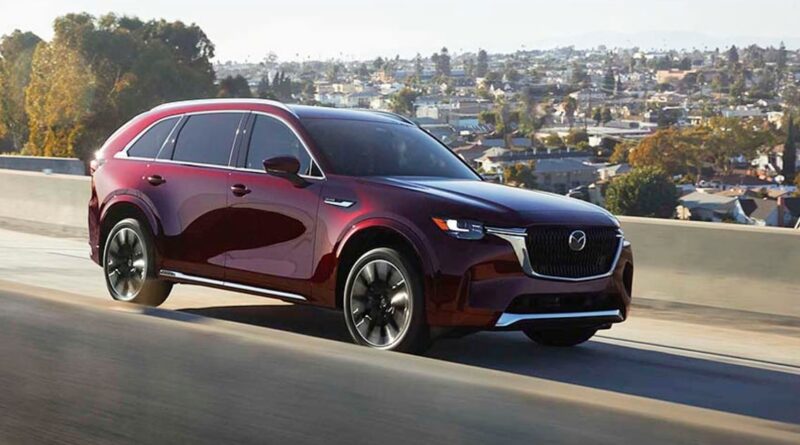Mazda races to feed U.S. demand for CX-90 amid looming shipping shortage
TOKYO – Export-dependent Mazda Motor Corp. expects a big surge in U.S. sales this year.
That is, if it can secure enough car carriers to transport its popular product from Japan.
A global shipping shortage is causing the Hiroshima-based automaker to scramble to secure enough sea transport to feed soaring demand for Mazda vehicles, especially its crossovers.
Mazda expects wholesale deliveries to jump 13 percent, or by 140,000 units, in the current fiscal year as it launches new nameplates such as the CX-90 and ramps up production.
About half of the projected increase is shipped out of Japan, incoming CEO Masahiro Moro said Friday.
But a combination of factors is putting a pinch on shipping logistics, he said.
During the pandemic, many ship companies decided to replace their fleets with more fuel-efficient vessels, and there is now a shortage of ships as new ones are being built.
Meanwhile, exploding auto exports from China are gobbling up space on available carriers. Last year, China exported about 3 million vehicles; this year exports could rise to 4 million, Moro said as Mazda announced its full fiscal-year financial results.
“This has led to more competition for ships,” said Moro, the former U.S. regional boss for Mazda who takes the global helm from current CEO Akira Marumoto in June.
“So, we are working hard to secure ships from Japan,” he added. “We are consulting with ship companies and working to standardize our shipping schedule as much as possible.”
Mazda imports about two-thirds of the vehicles it sells in the U.S. The import list includes the top-selling CX-5 compact crossover and the newly launched CX-90 large-sized crossover.
Pricing power
Mazda expects U.S. demand to swell this year, as it ramps up deliveries of the U.S.-built CX-50 and Japan-made CX-90 and cashes in on steadily improving U.S. pricing power for its products.
Rising revenue per vehicle in Mazda’s most important market helped propel a 36 percent surge in operating profit in the just-finished fiscal year, even amid falling unit sales.
The impact is the result of a brand-burnishing strategy years in the making.
Over the past four years, Mazda says, the brand’s average transaction price in the U.S. has risen by $7,000 – topping out at $33,700 in 2022, compared with $26,700 in 2018.
The shift drove Mazda to record-high annual revenue in the fiscal year ended March 31, 2023, even as global sales shrank to 1.11 million vehicles, from 1.56 million four years ago.
April’s introduction of the large-size CX-90 will further stoke U.S. sales while moving the brand’s position further upmarket. Meanwhile, output of the CX-50 will reach full swing in the fall.
“We hope to drive strong growth centering on our new product launches,” global sales chief Yasuhiro Aoyama said while announcing Mazda’s financial results. “We can achieve that.”
Alabama ramp up
The Alabama plant making the CX-50 has operated on a single shift since last year, as it sorts out quality and staffing issues. But from July, a second shift begins, opening the valve on output.
U.S. sales of the CX-50 totaled only 9,764 units in the first three months of 2023.
The Huntsville factory is jointly operated by Mazda and Toyota Motor Corp. with its total capacity of 300,000 split in half. Mazda has said the CX-50 alone could reach 150,000 units.
Mazda expects overall brand sales in North America, by far its biggest market, to rise 22 percent this fiscal year to 496,000 vehicles. That will power a 17 percent rise in global sales to 1.3 million.
In Europe, where the carmaker has introduced the new CX-60 crossover, volume is seen posting an 18 percent increase to 189,000 vehicles. Meanwhile, sales in China are forecast to rise to 125,000, as the carmaker adds localized production of the CX-50 in the world’s biggest car market.
The upbeat outlook comes after Mazda reported a downturn in its fiscal fourth quarter ended March 31. Operating profit fell 20 percent to 32.5 billion yen ($245.1 million) in the January to March quarter, while net income declined 25 percent to 39.2 billion yen ($295.6 million).
Global retail sales dipped 2 percent to 315,000 million units in the three months.
A massive surge in raw material and logistics costs dented the bottom line in the quarter.
Brighter outlook
But the picture was more positive for the full fiscal year ended March 31.
Over the 12 months, Mazda benefitted from rising wholesale shipments, a richer product mix, lower incentives and aggressive cost control. Foreign exchange rate windfalls also helped.
Operating profit climbed 36 percent to 142.0 billion yen ($1.07 billion), from the year before. Net income soared 75 percent to 142.8 billion yen ($1.08 billion) in the 12 months to March 31.
Mazda’s global wholesale deliveries expanded 7 percent to 1.06 million vehicles, as the semiconductor shortage eased and factory production gradually recovered.
Retail sales fell 11 percent to 1.11 million vehicles for the full fiscal year.
Mazda expects the positive momentum to continue.
Looking ahead to the current fiscal year ending March 31, 2024, it predicts operating profit will grow 27 percent to 180.0 billion yen ($1.36 billion).
Net income is forecast to decline 9 percent to 130.0 billion yen ($980.4 million).
Worldwide retail sales are seen expanding 17 percent to 1.3 million in the current fiscal year.
Source : Autonews.com




